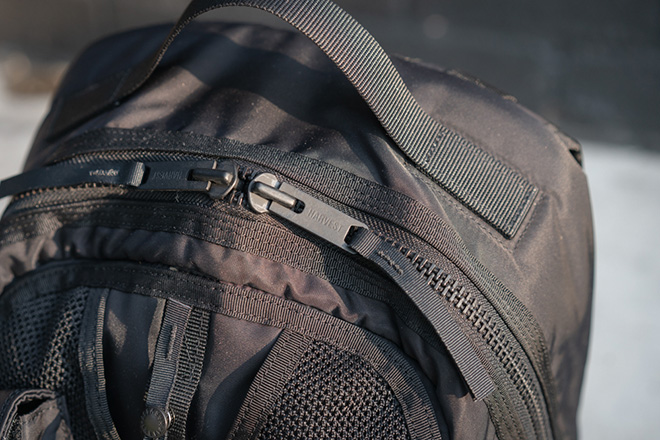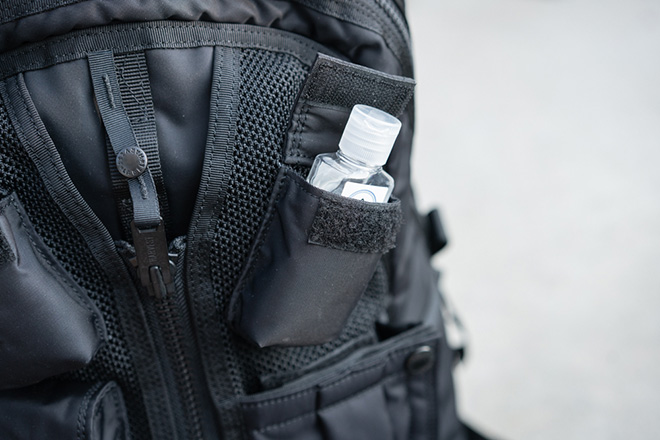Harvest Label Flyer’s 70XX Backpack Review
Brands and their designers often take inspiration from the past with the goal to build something new and improved for the present and the future. Take vehicle design as an example; the historic Ford Bronco returns this year reimagined for the modern off-roader. Yet it maintains recognizable style cues that made it an automotive icon, equipped with technology and innovation for a more capable and comfortable driving experience. Sneakerheads often hunt for releases of their favorite retro kicks or new models with signature colorways of the past as it brings up fond memories and nostalgic moments. The Japanese brand Harvest Label has revisited a discontinued model from their archives to reinvent the Flyer’s 70XX backpack for a modern, urban lifestyle.

The Harvest Label Flyer’s 70XX is based on the original Super Harcules series backpack that launched in 1998. This pack drew inspiration from classic military survival vests worn by military pilots. Harvest Label reproduced this original pack keeping the design DNA intact, while adding new materials and hardware, and improving the overall comfort, fit, and durability. One unique feature is the included removable internal storage organizer that attaches to the inner main compartment of the backpack, but can be used separately as a small sling bag.

I’ve had the opportunity to test the pack, using it mainly for daily work along with one photoshoot. I was unable to truly travel with it, but I do believe that it would travel well for most people.

Who It Suits
Anyone who loves military-inspired style and those looking for organization, versatility, and urban travel. Those who want something unique to add to their daily rotation. Fans of Japanese brands including Porter-Yoshida & Co.

Who It Doesn’t
Those who want a more minimalist style with less visible external storage compartments. Those who are not fans of the military aesthetic or require a specialty bag such as a camera pack. Also the budget-conscious as the backpack will be priced around $400 USD via Kickstarter.

The Good
Harvest Label is no stranger to bag-making. The decades of experience have helped to craft a thoughtful and successfully re-imagined pack that pays homage to their history. Produced in Higashi-Osaka City in Japan, the brand takes pride in the details and quality of work by each ‘shokunin’, the craftspeople responsible for each pack.

The design stands out and is unique with its external compartments/pockets and the combination of materials that marry well together. The tonal black on black colorway (of the pack tested) is subtle and sleek with only a single, small, discreetly placed brand label and embossed buttons. The main outer fabric is composed of three layers, which utilizes the same bonded fabric construction as an MA-1 bomber flight jacket complete with the slight sheen. The base of the pack is upgraded with Cordura nylon twill fabric with a DWR coating for durability and water repellency to help protect the contents from the elements and daily use. Additionally, this material is bluesign® approved, which signifies it was made with sustainable manufacturing practices.

The brand opted for high-quality hardware including metal YKK zippers that were manufactured in Japan to pair with the metal zipper pulls, strap components, and snap button caps. I particularly like the snap button used in the front/center of the pack that holds the mesh internal compartment.

Where the Harvest Label Flyer’s 70XX Backpack shines is in its robust offerings for storage and organization. The pack is well equipped with a multitude of pockets, compartments, and even secret zippered stash slots. The main compartment is large with ample internal storage space along with a padded laptop sleeve with a Velcro enclosure. The padded laptop sleeve is cleverly designed to fold down for easy access. It can fit up to a 16-inch MacBook Pro.

Additionally, the bonus internal organizer is removable and snaps into place with two buttons. I found this to be another smart and convenient feature that adds to the overall versatility of the pack, but preferred using this independently rather than worn simultaneously with the backpack.

The organizer unsnaps quickly and folds twice to then snap together for a small-sized carry solution. The included shoulder strap adjusts in length and makes it easy to be worn over the shoulder, across the body, and over the neck. The strap is removable in case you want to use it as a clutch or if you simply don’t want to keep the strap connected when it’s attached inside the pack. The organizer has three enclosed storage pockets – one zippered mesh, one Velcro enclosed slot, and one Velcro enclosed pocket. It also includes a minimal Harvest Label branded tag. This can be useful to grab your essentials and stay light when you’re on the go.

The backpack’s exterior features no less than ten compartments of various shapes and sizes. This does provide a lot of options for quick-access organization. The centered zippered mesh compartment is reminiscent of an outdoor vest. It opens up to two nylon straps that can secure and hold an umbrella and a standard-sized water bottle.

Another clever feature that draws in the military vibe is the hook and loop panel on the bottom left compartment. The pack comes with both a tonal circular patch, which I didn’t notice at first, as well as a cover for an even more streamlined look. I prefer the cover myself but do like having the option to add a bit of personalization.


I found the pack to be overall comfortable. The pack itself weighs about 3.3 lbs with the internal organizer or 3 lbs without, which is on the moderate end. Yet it feels light when worn, possibly due to the weight distribution in the design that balances the pack.

The padding is generous and can be found on the back of the pack and on the shoulder straps. It’s a bit thicker than most packs but helps for extra airflow along with adding extra protection for a laptop. I particularly appreciate that it’s soft and smooth to the touch versus other materials like AirMesh that tend to make some clothing pill up after time. The shoulder straps are easily adjustable to size and the extra webbing can be neatly rolled up. The top grab handle is convenient and strong due to the heavy-duty webbing. It’s not padded, but it does the trick.

Finally, Harvest Label offers a limited lifetime warranty for manufacturing defects and will replace, repair, or refund the owner if something were to happen. They offer at-cost repair for general wear and tear problems that can arise from daily use.


Not So Good
This design may not be for everyone, but that is more a matter of personal tastes. I do like the military aesthetic and choice of materials. However, the pack may not offer the most protection from the elements. If you’re caught in the rain, contents behind the mesh can easily become wet, so you have to be careful what you choose to pack in there.

The size of the exterior compartments are a bit odd in offerings. Two very small pockets only hold items the size of lip balm, personal-sized hand sanitizer, or a rolled cable. The flat Velcro pocket has noticeable folds, which I believe is intentional for the design and possibly adds to protecting the contents such as a pair of sunglasses. But this is probably not the most ideal placement for a pair of shades.

The removable waist belt is fairly simple and does help to relieve some of the weight for longer walks. But I preferred to remove it completely. I found the choice of hardware to tighten the waist strap didn’t match the overall modern design qualities. It’s easy to use, but it has a more industrial and vintage look and feel than the rest of the hardware and materials.

One last thing that I found was that the nylon straps found under the mesh compartment are solid and stiff. It does work overall as intended. But I think elastic nylon straps would better suit the intent for these straps to ensure the items are secured in place.

Verdict
The Harvest Label Flyer’s 70XX successfully fuses classic design with new innovation and styling. The military vibe isn’t over the top and works well for the pack’s utility and function. The high-quality materials and components stand out and ensure the brand’s high standards are met to satisfy the owner. The pack’s warranty and available repair option suggest this pack should last a long time.

The pack works well for daily use and travel alike. But it may need to be reconsidered for those who are often in wet conditions.
Overall, the brand has dug into their archives to produce a pack built for the modern, urban explorer. The price point may deter most but those who can afford it will be sure to own a one-of-a-kind pack.

The pack is available now via Kickstarter and is available in three colorways.






 Carry Awards
Carry Awards Insights
Insights Liking
Liking Projects
Projects Interviews
Interviews













One thought on “Harvest Label Flyer’s 70XX Backpack Review”
Comments are closed.